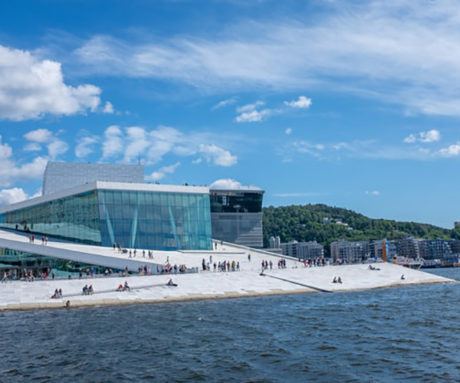Explore Norway’s sophisticated capital of Oslo

Norway’s sophisticated capital of Oslo conjures images of stunning architecture, a vibrant culinary scene and Viking museums, but it’s often thought of as being an expensive city to visit.
However, if you’re heading to Norway on an Arctic expedition, it would be an incredible shame to miss out on what Oslo has to offer. That’s why we’ve put together some of the top free activities in Oslo for the budget conscious traveler.
1. Marvel at the futuristic Oslo Opera House

Home to the Norwegian National Opera and Ballet, the Oslo Opera House is truly an architectural spectacle to behold. Several art projects were commissioned for the interior and exterior of the Opera House. The most notable is She Lies, a sculpture constructed of stainless steel and glass panels by Monica Bonvicini. It is permanently installed on a concrete platform in the fjord adjacent to Opera House and floats on the water moving in response to tides and wind to create an ever-changing face to viewers. Sitting on the bank of the Oslofjord, the building appears to rise out of the water like a small iceberg, its angular lines enabling visitors to walk up to the roof for a great view of the fjord and the rest of the city.
2. Peruse the collection at the Nasjonalgalleriet
Norway’s largest public collection of sculptures and paintings offers free entry on Thursdays, and houses a range of incredible artworks, including ‘The Scream’ by Edvard Munch.
The museum also has old master European paintings by painters such as El Greco, Lucas Cranach the Elder (Golden Age), Gaulli (Sacrifice of Noah), Orazio Gentileschi, Artemisia Gentileschi, Andrea Locatelli (Bachannal Scene), Pieter Elinga (Letter Carrier), Ferdinand Bol, Daniel De Blieck (Church Interior), Jacob van der Ulft (Seaport), Cornelis Bisschop (Seamstress) and Jan van Goyen. There are also 19th and 20th Century International paintings by Armand Guillaumin, Carl Sohn, Auguste Renoir, Claude Monet (Rainy Day, Etretat), Paul Cézanne, and Pablo Picasso. There are also Norwegian paintings by Adolph Tidemand, Hans Gude, Harriet Backer, and Lars Jorde.
3. Discover Norway’s past at the Askerhus Fortress
Construction of the medieval Askerhus Castle and Fortress first began all the way back in 1299. It was built to protect and provide a royal residence for the city. Since the Middle Ages the fortress has been the namesake and centre of the main fief and later main county of Akershus, which was originally one of Norway’s four main regions and which included most of Eastern Norway. A great place to catch a glimpse of Norway’s past, you can roam the grounds of the fortress on a guided tour during summer.
4. Mingle with the locals at the market
If you want to rub shoulders with Oslo locals away from the tourist sites, head to one of the city’s various markets. Vestkanttorvet is Oslo’s largest and oldest second hand and antiques market, taking place on Saturdays from March to December. Another popular spot is the Birkelund flea market in Grünerløkka – held on Sundays, it’s the perfect place to find a bargain souvenir of Oslo.
5. Go for a swim at Huk
If you’re staying a day or two in Oslo, why not head to the beach? Simply catch the 30A bus to the end of the line at Bygdøy peninsula and dive into the water at Huk. The area was acquired by Aker municipality in 1921. The bathing beach is divided into a regular public beach and a naturist beach area.
6. See the changing of the guards at Palace Park

While you will have to pay for a guided tour of the Royal Palace, home to King Harald and Queen Sonja, the Palace Park that surrounds it is free for all to enjoy. You can even catch the daily changing of the guards at 1:30pm.
7. Marvel at the beauty of Oslo City Hall
The Oslo City Hall is arguably one of the capital’s most iconic buildings, featuring a large number of motifs that illustrate Norwegian history and culture. From July to the end of August, you can explore the hall on a free guided tour.
8. Take a peek at Vigelandsparken Sculpture Park

This beloved park is one of the country’s most popular attractions featuring a truly unique collection of sculptures. Over 200 of Gustav Vigeland’s bronze, granite and cast iron works depicting the human form are spread throughout the park, including Sinnataggen (The Little Angry Boy), Monolitten (The Monolith) and Livshjulet (The Wheel of Life). It’s the largest park in the city and covers 45 hectares; the sculpture installation is the world’s largest sculpture park made by a single artist. The Vigelandsparken Sculpture Park is the most popular tourist attraction in Norway, with between 1 and 2 million visitors each year, and is open to the public at all times.
By Craig Upshall
